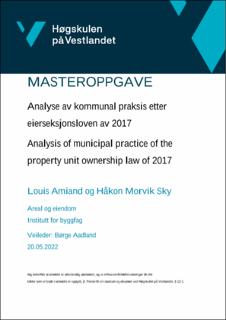| dc.contributor.author | Amiand, Louis | |
| dc.contributor.author | Sky, Håkon Morvik | |
| dc.date.accessioned | 2022-09-09T06:58:22Z | |
| dc.date.available | 2022-09-09T06:58:22Z | |
| dc.date.issued | 2022 | |
| dc.identifier.uri | https://hdl.handle.net/11250/3016743 | |
| dc.description | Masteroppgave i areal og eiendom.
Fakultet for ingeniør- og naturvitskap/ Institutt for byggfag/ Høgskulen på Vestlandet, campus Bergen. | en_US |
| dc.description.abstract | Denne oppgaven handler om Oslo og Bergen kommunes praksis etter eierseksjonsloven. Vi har innhentet avslag og avvisninger på søknader om seksjonering/reseksjonering fra loven trådte i kraft, til og med januar 2022. Hensikten med dette var å undersøke på hvilket grunnlag kommunene fatter vedtak om avslag eller avvisning og for å se om det var noen særskilte forhold som er særlig fremtredende. For å finne ut av dette har vi formulert den følgende hovedproblemstillingen:
«Hvilke forhold er grunnlag for avslag/avvisning ved søknad om seksjonering/reseksjonering etter eierseksjonsloven § 12, i Oslo- og Bergen kommune».
Hovedproblemstillingen er konkretisert videre gjennom fire underproblemstillinger:
(1) Finnes det noen klare ulikheter mellom avslag på søknad for store og små sameier?
(2) I flere av avslagene har eiendommen blitt seksjonert eller reseksjonert på et senere tidspunkt. Hva skiller disse sakene, fra de sakene som ikke har blitt seksjonert eller reseksjonert på et senere tidspunkt?
(3) Finnes det noen klare ulikheter mellom avslag på søknad om seksjonering, reseksjonering jf. eierseksjonsloven § 20 og reseksjonering jf. eierseksjonsloven § 21?
(4) Hva er typisk for søknadene som har blitt avslått med hjemmel i eierseksjonsloven § 7 tredje ledd (koblingsregelen)?
Vi har gjennom en kvantitativ innholdsanalyse utredet de fire forholdene for å avdekke hva kommunene hjemler vedtak om avslag og avvisning i. I analysen har vi rettet fokus mot materielle vilkår etter § 7 og de formelle kravene etter § 11. I tillegg har vi undersøkt andre forhold som er relevant etter eierseksjonsloven. Dette inkluderer hvilken type søknad som er fremsatt, om søknaden gjelder store eller små sameier og hvorvidt eiendommen har blitt seksjonert eller reseksjonert på et senere tidspunkt. Vi har også gjort en sammenligning mellom Oslo og Bergen, som følger av Vedlegg 1.
Studien inkluderer også klagesaker etter eierseksjonsloven som er behandlet av Statsforvalteren i Vestland, Trøndelag og Oslo og Viken. Innholdet fra klagesakene blir brukt for å avklare særskilte forhold i drøftingen.
I resultatkapittelet avdekker vi en del ulikheter knyttet til de fire underproblemstillingene. Det vises også til generelle funn fra analysen, som kan bidra til å besvare hovedproblemstillingen. | en_US |
| dc.description.abstract | This thesis is about Oslo and Bergen municipality’s practice of the property unit ownership act. We have obtained the applications for sectioning/resectioning of properties, which have been refused or rejected by Oslo and Bergen municipality. The applications gathered for this study are dated from when the law took effect, until and including january 2022. The purpose of this was to investigate on what basis the two municipalities make the decision to refuse or reject the applications, and If there were any special circumstances which is particularly prominent. In order to make any assumptions, we formulated the following thesis statement:
«Which circumstances are grounds for refusal/rejection of applications for sectioning/resectioning according to the property unit ownership act § 12, in the municipalities of Oslo and Bergen?»
The main thesis statement is further concretizes through four sub-statements:
«(1) Are there any clear differences between the refusals or rejections of applications for large and small condominiums?
(2) In several of the refusals nad rejections, the properties have been sectioned/resectioned at a later date. What distinguishes these cases from those that have not been sectioned/resectioned at a later date?
(3) Are there any clear differences between the refusals/rejections of an application for sectioning, resectioning cf. The property unit ownership act § 20 and resectioning, cf. § 21?
(4) What is typical of the applications that have been rejected on the basis of the property unit ownership act § 7 third paragraph?»
Through a quantitative content analysis, we have investigated the four substatements in order to uncover what the municipalities base their refusals/rejections on. In the analysis, we have focused on the material terms for sectioning/resectioning according to § 7, and the formal requirements in § 11. In addition we have examined other factors which are relevant under the property unit ownership act. This includes which type of application that have been submitted, whether the application concerns large og small condominiums and whether the properties have been sectioned or resectioned at a later date. We have also made a comparison between Oslo and Bergen, which Is included as Appendix 1.
The study also includes complaints under the property unit ownership act, which are dealt with by the State Administrator in Vestland, Trøndelag and Oslo og Viken. The content of the complaints is used to clarify special matters in the discussion
In the results, we uncover a number of differences related to the four substatements. There is also some general findings from the analysis presented in the results, which may help to answer the thesis statement. | en_US |
| dc.language.iso | nob | en_US |
| dc.publisher | Høgskulen på Vestlandet | en_US |
| dc.rights | Navngivelse 4.0 Internasjonal | * |
| dc.rights.uri | http://creativecommons.org/licenses/by/4.0/deed.no | * |
| dc.title | Analyse av kommunal praksis etter eierseksjonsloven av 2017 | en_US |
| dc.title.alternative | Analysis of municipal practice of the property unit ownership law of 2017 | en_US |
| dc.type | Master thesis | en_US |
| dc.description.localcode | MOA300 | en_US |

